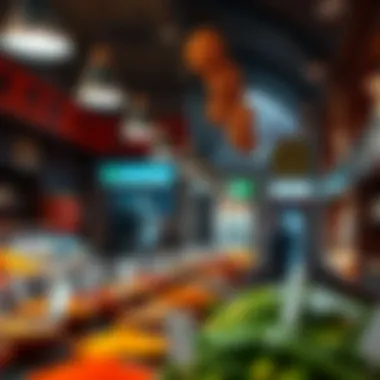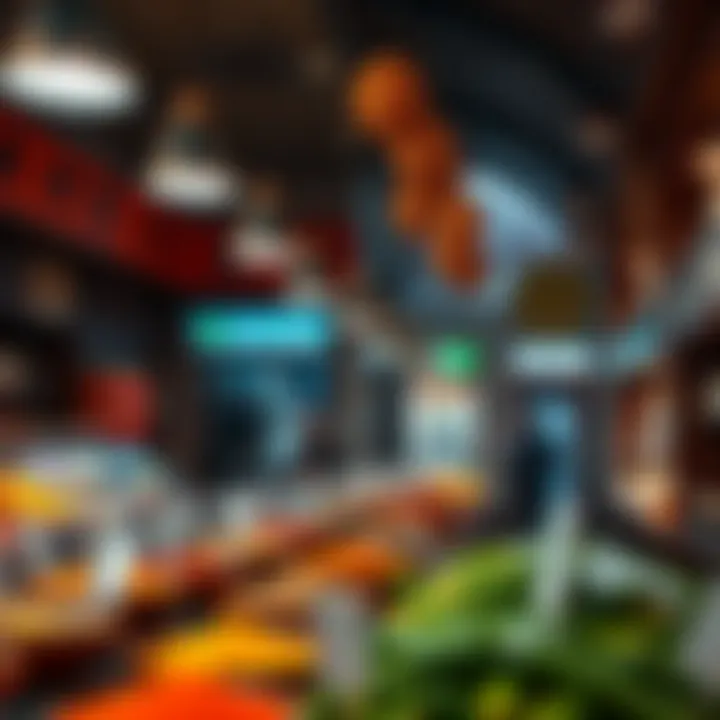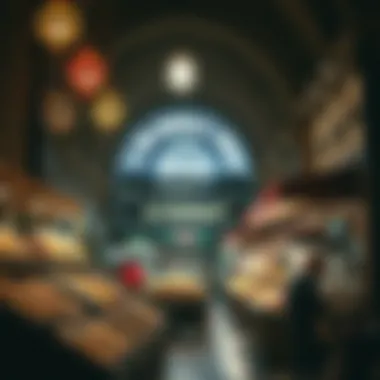Discover the Flavors of Dubai's Spice Market


Intro
The Dubai Spice Market, also known as the Souk Al Bahar, is not just a market but a tapestry woven from the rich threads of history, culture, and commerce. Every corner of this vibrant space tells a story of trade routes that have crisscrossed through the Arabian Peninsula for centuries. Walking through, visitors are often greeted by a symphony of scents: the warm notes of cardamom, the earthy aroma of cumin, and the sweet fragrance of saffron mingling together in an enticing embrace. This market serves as a testament to Dubai’s historical significance as a junction for spices and a melting pot of diverse cultures.
In this article, we will delve into the fascinating layers and multifaceted nature of the market. Through exploring its origins, the vast array of spices available, and the impact of global trends on local practices, one can grasp the essence of what the Souk Al Bahar represents today. Moreover, those with an eye on investment will find insights into the economic significance of such spaces in the rapidly evolving landscape of Dubai.
The Dubai Spice Market is more than just a place to buy spices; it’s a vibrant testament to the cultural exchange and trading practices that have shaped the region. Understanding this allows investors, agents, and property managers to appreciate its value not just as a retail spot, but as an integral part of Dubai’s economic and cultural framework.
As we journey through the flavors and traditions of the market, the reader will uncover how these influences interrelate, creating a unique experience that is not just about commerce, but also about connection and history.
Historical Context of the Spice Market
The spice market in Dubai is more than just a marketplace filled with colorful spices; it serves as a vivid tapestry of history, culture, and trade. This historical context is essential to understanding the current significance of the the market and its role in global commerce. Over centuries, Dubai has transformed from a small trading outpost to a bustling nexus of international trade, primarily driven by its strategic location along vital maritime routes.
The Emergence of Spice Trade in Dubai
The rise of Dubai’s spice trade traces back to the early days of the fishing and pearl diving economies. The port of Dubai was perfectly positioned to become a central hub for spice traders who traveled from far and wide, bringing ingredients from Asia, the Middle East, and beyond. Traders would gather at the harbor, exchanging not just spices but also stories of distant lands. As demand for exotic flavors surged, local merchants quickly adapted, ensuring that spices were not only available but also affordable. The blend of Persian, Indian, and Arab cultures further enriched the spice offerings available today.
Cultural Significance Over Centuries
For centuries, spices were more than mere commodities; they held immense cultural and culinary significance. In traditional Emirati households, spices such as saffron, cardamom, and turmeric are integral to the preparation of dishes like biryani and majboos. They are symbols of hospitality and generosity. Back in ancient times, the exchange of spices was a means of fostering relationships between various cultural groups. The souk, as it stands today, is not just a place to buy and sell; it's a living museum that showcases the region's rich culinary traditions, spilling out stories into every packet of spices sold.
Influence of Ancient Trade Routes
The spice market’s influence can’t be detached from ancient trade routes that shaped trade dynamics. The Silk Road and Maritime Spice Route played crucial roles in the connections between continents. With the establishment of these trade routes, spices traveled across lands creating a web of economic interdependence between Europe, Asia, and Africa. Even in contemporary usage, one can see the remnants of this ancient trade: garlic and ginger, for example, are foundational in Middle Eastern cuisine and signify deep-rooted traditions. The spice market still resonates with the whispers of trades from long ago, each spice holding a story that dates back to a time when spices were worth their weight in gold.
"A sprinkle of the past, the essence of culture, and a dash of trade; the Dubai spice market is where history and flavors collide."
The historical context enriches the marketplace experience for visitors, investors, and culinary enthusiasts alike. It offers insights into how culinary practices can evolve, yet retain ties to their origins, making the Dubai Spice Market a compelling case study in historical continuity. Understanding this historical framework lays the groundwork for appreciating the vibrant market that flourishes today.
Architecture and Layout of the Spice Market
The architecture and layout of the Dubai Spice Market play an integral role in shaping the overall experience that visitors encounter. With its design mirroring the traditional souks that have existed for centuries, this market stands as a testimony to the cultural heritage of Dubai. Through the clever integration of various architectural elements, the market not only attracts tourists but also serves the functional needs of local traders and consumers alike.
Design Elements Reflective of Traditional Markets
The design elements of the Spice Market are rooted in the rich history of Middle Eastern markets. The expansive wooden beams and arched ceilings are reminiscent of centuries-old trading posts, evoking a sense of nostalgia and authenticity.
- Open Layout: The market features an open layout, allowing for ease of movement and enabling visitors to explore the numerous stalls without feeling cramped.
- Natural Light: Skylights flood the pathways with sunlight, welcoming visitors while reducing electricity costs for traders.
- Cultural Motifs: Intricate tile work and geometric patterns adorn the surfaces, echoing traditional Islamic artistry that is prevalent throughout the region.
This architectural design not only provides a visual feast but enhances the sense of place, encouraging a connection to Dubai's past commerce and trade.
Navigation Through the Market Aisles
Moving through the market aisles is akin to embarking on a sensory-filled journey. The layout is crafted to facilitate easy navigation, making it a delight for both seasoned visitors and first-time explorers.
- Signage in Multiple Languages: Clear signage, often in both Arabic and English, guides visitors through various sections devoted to specific spices, herbs, and other culinary delights.
- Wide Aisles: The aisles are generously designed, enabling visitors to weave through bustling crowds without a hitch, all while taking in the surrounding aromas.
- Specialty Zones: Distinct areas are set up for particular types of spices, where vendors often share stories behind their offerings. This method encourages cultural exchange, fostering a deeper understanding of the local culinary landscape.
A subtle yet deliberate layout ensures that newcomers and regulars alike feel comfortable as they traverse the vibrant market, perhaps leading them to discover new and exciting flavors.
Artistic Features and Craftsmanship


Artistry and craftsmanship are the lifeblood of the Dubai Spice Market. Every stall is a showcase of creativity, reflecting the skill and dedication of local artisans.
- Handcrafted Goods: Many vendors offer handcrafted spice containers, such as small jars that display their wares beautifully. This emphasizes the market's commitment to artisanal quality.
- Decorative Displays: Spices are often displayed in colorful heaps, appealing to the eye. The vibrant hues of saffron, chili, and cardamom create a pulsating backdrop, enhancing the visual appeal of the market.
- Cultural Integration: Traditional calligraphy and artwork feature prominently, reinforcing local identity and values through visual storytelling.
The blend of art and commerce creates a lively atmosphere, inviting every attendee to not just shop, but to appreciate the rich culture that each spice represents.
"The architecture of Dubai has always been a convergence of the past and future, where history meets innovation to create a truly unique experience."
In essence, the architecture and layout are crucial to the functionality and the enchanting experience offered by the spice market, providing an immersive environment where visitors can forage through layers of cultural richness and flavorful exploration.
For more about historical markets, visit Britannica or explore cultural insights at Wikipedia.
Diversity of Spices Available
The diversity of spices within the Dubai Spice Market is not merely a testament to the range of flavors that brighten Emirati cuisine. It symbolizes centuries of trade, cultural exchange, and culinary innovation that define the essence of the market. Each spice tells a story of its origin, uses, and significance, offering insights into the region's rich history and ongoing traditions.
Common Spices and Their Uses
In the bustling aisles of the market, common spices such as cumin, cardamom, and coriander stand out. These staples are not just flavor enhancers; they are integral to various traditional dishes. For instance, cumin is often found in the renowned lamb dish, lamb kabsa, adding a warm, earthy depth. Cardamom, fragrant and sweet, is used in coffee preparations which form an important ceremonial aspect of Emirati hospitality. Moreover, coriander, with its vibrant green leaves, finds its way into salads and garnishes, pushing forth a freshness to many meals.
Each of these spices carries its own culinary legacy, making them staples in kitchens across Emirates and beyond. The spices are versatile, filling the air with a symphony of aromas that lure both locals and tourists to explore further.
Exotic Spices and Specialties
Venturing deeper into the market, the exotic spices begin to reveal their allure. Rare finds such as saffron, sumac, and mace highlight the expansive trade routes that brought these treasures to Dubai. Saffron, with its crimson strands, is often touted as the world’s most expensive spice. It’s frequently used in biryanis and sweets, where its distinctive flavor and vibrant color elevate the dish to royalty.
Sumac, on the other hand, brings a tartness reminiscent of lemon, providing refreshment to salads and grilled meats. Meanwhile, mace, the outer covering of nutmeg, adds a sweet and aromatic spice to both savory and sweet dishes, showcasing its versatility. Collectively, these ingredients tell the narrative of Dubai's spice heritage; they reflect not only global culinary trends but also local adaption.
Herbs, Teas, and Other Botanicals
Beyond the vibrant spices, a variety of herbs, teas, and botanicals occupy space in this aromatic haven. Zaatar, made from zaatar leaves, sesame seeds, and sumac, is a prominent herb blend that garnishes bread, meats, and salads, linking diners to authentic Emirati dining experiences. Additionally, the fragrant rose petals and dried mint can transport dishes to a whole new sensory level, allowing unique fusions in culinary traditions.
In the tea section, one can find chai blends infused with cardamom, cinnamon, and cloves, each promising to impart a distinctive flavor experience. These blends not only warm the body but also offer a glimpse into the culture surrounding hospitality in the UAE.
"The spice market is a mosaic of flavors and scents, reflecting the shared histories of those who came to trade here over the centuries."
Culinary Uses and Cultural Integration
Culinary uses and cultural integration stand as pillars in the narrative of Dubai's spice market. This bustling hub of flavors not only showcases the wide variety of spices but also acts as a living testament to the intermingling of traditions and culinary practices. The significance of culinary uses transcends beyond simple flavor enhancement; it embodies a rich history and a diverse cultural tapestry.
Spices in Traditional Emirati Cuisine
In the heart of Emirati cuisine lies a delicate blend of spices that speaks to the region's cultural heritage. Common spices such as saffron, cardamom, and cumin play pivotal roles in traditional dishes like Al Harees and Majboos. Each spice brings its own story, often intertwined with ancient trade routes that introduced these ingredients to the local palate.
For instance, saffron, prized for its unique flavor and vibrant hue, was not always a local staple. It found its way to the region through traders from Persia and India, and its incorporation into dishes reflects a melding of influences. The importance of such spices extends into family gatherings and celebrations, where they signify hospitality and community bonding. The careful selection and application of spices in Emirati cooking not only enhance flavors but also preserve a culinary identity that has been nurtured through generations.
Role of Spices in Regional Dishes
Beyond Emirati cuisine, spices influence a myriad of regional dishes throughout the Gulf Cooperation Council (GCC) countries. Spices such as za'atar, sumac, and paprika have seeped into everyday meals, showcasing the interconnectedness of Middle Eastern culinary habits. Dishes like Shawarma and Falafel have captured traditional flavors while adapting to local palates, making them popular far beyond their origins.
Furthermore, spices not only influence taste but also health perceptions. Turmeric, known for its anti-inflammatory properties, has made its way into countless local recipes as a healthful ingredient. This adaptability shows how spices can traverse cultural boundaries, leading to innovative dishes that maintain their roots while embracing new culinary ideas. In essence, the role of spices in regional dishes is a harmonious blend of tradition and modernity, allowing for an ongoing dialogue among cultures.
Global Influence of Dubai's Spice Culture


The spice market in Dubai serves as a gateway, inviting influences from around the world. As Dubai transforms into a global hub for tourism and commerce, so too does the culinary landscape evolve. Spices from Southeast Asia, Mediterranean regions, and beyond are embraced, blending with local flavors to create unique fusion dishes. Visitors to the market witness firsthand the confluence of cultures, where a sprinkle of cardamom might accompany a Thai curry while saffron enhances a traditional Persian dish.
"The spice market not only represents a trade route of ingredients but also a marketplace of ideas and flavors, reflecting a world without borders."
This global influence is not just limited to culinary exploration; it extends to cultural exchanges. Food festivals, cooking classes, and guided tours cultivate an appreciation for spice and its role in different cuisines, encouraging locals and tourists alike to explore culinary diversity. Moreover, the continuous interaction between local chefs and international culinary artists inspires new recipes, showcasing how Dubai's spice culture evolves while maintaining deep-rooted traditions.
Economic Impact of the Spice Market
The spice market in Dubai is not just a hub for aromatic treasures; it also plays a pivotal role in the economic landscape of the city. This section will explore the intricate dynamics of the market, highlighting how it contributes to the robust economy of Dubai, along with the challenges it faces in modern trading scenarios. Understanding the economic impact can provide valuable insights for investors, agents, and property managers looking to navigate this unique marketplace.
Market Dynamics and Pricing Strategies
Within the bustling corridors of the spice market, pricing is influenced by a mix of factors, including supply chain logistics, seasonal demand, and the origins of the spices themselves. Spices sourced from regions like India and Sri Lanka often have different pricing strategies compared to local herb suppliers.
- Competition: The market hosts numerous vendors, each vying for consumer attention. This competition helps keep prices relatively moderate.
- Bulk Purchasing: Many traders offer discounts for bulk purchases, making it more economical for restaurateurs and specialty shops.
- Quality versus Price: There is a delicate balance between maintaining quality and setting competitive prices. High-quality spices, often sourced through ethical means, tend to command higher prices due to their perceived value.
Prices can fluctuate significantly, driven by external factors such as trade regulations or shifts in global demand. Investors who recognize these patterns can better forecast market movements.
Contribution to Dubai's Economy
The spice market’s contribution to Dubai's economy extends beyond direct sales. It generates employment, boosts tourism, and enhances the cultural fabric of the city. The market attracts visitors seeking authentic experiences, making it a significant stop in the city’s tourism circuit.
- Employment Generation: Thousands of jobs are tied to the spice trade, from the vendors and traders to logistics personnel involved in the import-export of spices.
- Tourism Magnet: The atmosphere of the market draws tourists not just for shopping but for cultural immersion. Visitors often stop by the nearby Dubai Creek to enjoy a full spectrum of local activities.
- Culinary Capital: As a center for exotic flavors, the spice market aids in elevating Dubai’s status as a culinary capital, encouraging chefs and food enthusiasts to explore unique ingredients.
This interwoven relationship with tourism and employment emphasizes the market's significance in Dubai’s economic fabric.
Challenges Faced in Modern Trading
Despite its importance, the spice market faces a plethora of challenges that can impact its viability. Technological advancements, market accessibility, and consumer preferences are key areas affecting operations.
- Digital Disruption: E-commerce platforms have changed the way people shop for spices. Many consumers prefer online shopping for convenience, which can divert foot traffic from physical locations.
- Regulatory Hurdles: Import regulations can prove cumbersome for traders, especially those dealing with high-demand spices. Consistency in supply lines has become a pressing issue for vendors who depend on imported goods.
- Changing Consumer Preferences: Modern consumers are leaning more towards healthy eating and sustainability, pressuring businesses to adapt their offerings. Local sellers who can harness organic or sustainably sourced spices may find themselves at an advantage.
Addressing these challenges is crucial for the spice market’s continued contribution to Dubai’s economy. Vendors and stakeholders must remain flexible and innovative to navigate the evolving landscape.
Tourism and Visitor Experience
The Dubai Spice Market is not just a place to buy spices; it’s a vibrant tapestry of flavors, aromas, and cultural interactions that draws visitors from all corners of the globe. Tourism and visitor experience in this market are critical for understanding how the spice trade has evolved and continues to be a beacon of cultural and commercial exchange. It's here that travelers can immerse themselves in the essence of Dubai, feeling the pulse of its rich history and contemporary lifestyle.
Visitors to the market can expect to encounter a spectrum of attractions and activities that engage all senses. Whether you’re a gastronome in search of exotic flavors or a curious traveler wanting to witness the bustling life of the souk, there’s much on offer in this enchanting setting. However, it’s essential to navigate this sensory overload with a bit of foresight and respect for the local customs that enrich the experience.
Attractions and Activities in the Market
The spice market is a kaleidoscope of sights and sounds, filled with countless attractions that cater to both seasoned travelers and newcomers alike.
- Spice Stalls: Vendors line the market with vibrant displays of saffron, cardamom, and more, each container bursting with colors and fragrances.
- Culinary Workshops: Some stalls provide cooking demonstrations or offer workshops that invite visitors to learn about spice blends used in traditional Emirati cooking.
- Cultural Exhibits: As you meander through the aisles, you may find exhibitions spotlighting the historical significance of various spices, enriching the visitor experience.
"In the heart of the spice market, you’re not just a spectator; you are part of a living history, engaged with generations who have walked these paths before you."
Interacting with the locals can also enhance your journey. Engaging in conversation with spice vendors not only allows for authentic encounters but often provides insights into the uses and stories behind the products.
Navigating the Market: Tips for Visitors
To make the most of your visit, consider these practical tips for navigating the spice market:


- Timing: Early morning or late afternoon are ideal times to visit, when the market is less crowded, allowing you to explore at your own pace.
- Bring Cash: While some vendors accept credit cards, many still prefer cash transactions. Having dirhams handy will facilitate easy purchases.
- Bargaining: Don’t shy away from haggling. It’s not just accepted; it’s expected, and adds to the local experience. Start lower than your desired price and negotiate from there.
- Stay Hydrated: The market can get hot and stuffy, so keep a bottle of water handy, especially if you’re visiting during the peak sun hours.
Being prepared can transform your visit into a seamless journey through this vivid marketplace.
Cultural Etiquette and Practices
Experiencing the Dubai Spice Market goes beyond the fragrant products on display. Understanding and respecting local customs are paramount for any visitor looking to fully appreciate this cultural gem.
- Dress Modestly: While Dubai is cosmopolitan, it’s best to dress respectfully, particularly in traditional markets. Opt for clothing that covers shoulders and knees.
- Greetings: Engaging with vendors can be gratifying; a friendly "Salam Alaykum" (Peace be upon you) can go a long way in establishing rapport.
- Respect Purchasing Dynamics: Many stalls operate on a cash basis, and locals often engage in a social context while trading. This adds into the interactions, making them richer than simple business transactions.
- Photography: Always ask for permission before taking photographs, especially of vendors or patrons. Respect for privacy is vital.
These nuances will not only help in understanding the ethos of the market but will also enhance your overall experience, making it a truly memorable visit.
Future of the Dubai Spice Market
As the world becomes increasingly interconnected, the future of the Dubai Spice Market is a subject of great relevance. Not just in preserving its rich heritage, but also in adapting to the changing dynamics of trade and consumer preferences. This section delves into key elements that will shape the market moving forward, with a sharp focus on sustainability, technology integration, and evolving consumer trends.
Sustainability and Environmental Considerations
Sustainability has evolved from being a buzzword to a necessary practice within commerce. While the Dubai Spice Market attracts visitors with its colorful spices, it faces unique environmental challenges. To ensure the market's longevity, local vendors must consider the sourcing of their spices. Many spices require specific growing conditions which may be hampered by changing climates.
Ensuring that spices are grown sustainably can protect local ecosystems. Moreover, initiatives like reducing plastic packaging and exploring biodegradable options are essential steps. Buyers, particularly those in a growing eco-conscious demographic, are increasingly prioritizing sustainable products.
Implementing sustainable practices not only benefits the environment, but may also enhance the market's reputation globally. This dedication can attract tourists and investors who appreciate responsible business practices.
Integration of Technology in Traditional Markets
In a landscape brimming with digital acceleration, the infusion of technology into traditional markets like Dubai's Spice Market is inevitable. Here, technology doesn't mean sacrificing culture but rather enhancing the buying experience.
Imagine mobile apps that provide buyers with information about the origin and quality of spices. Or digital payment systems that streamline transactions. Vendors could leverage social media to market their products, making it easier to reach customers beyond the physical confines of the market.
Also, augmented reality might allow visitors to explore a virtual landscape of spices. They could receive detailed information on each spice's culinary uses or historical background by simply scanning a code on their smartphones. Such integrations will bridge the gap between tradition and modernity, ultimately fostering a more engaging environment for both local and international visitors.
Evolving Consumer Preferences and Market Trends
Today's consumers are not just purchasing spices; they're investing in experiences. They seek authenticity and stories behind the products they buy. For the Dubai Spice Market, this means evolving with these shifting preferences.
Increased demand for organic products means that vendors must adapt. Offering purely organic and locally sourced spices could cater to a clientele that values health and wellness. Moreover, trends towards fusion cuisines can also open doors to innovative offerings and spice blends that combine regional ingredients in unique ways.
Additionally, the rise of food tourism has shot up with culinary enthusiasts seeking unique flavors. Hence, the Spice Market should think about hosting cooking classes or spice tasting events. This would not only provide an income stream but also create a community of devoted customers who return for both the products and the experiences.
"The Dubai Spice Market must remain dynamic to stay relevant in a rapidly changing world."
All these aspects point to a future where the Dubai Spice Market preserves its cultural integrity while also embracing the evolution that comes with modern consumer habits. Staying attuned to sustainability, technology, and ever-changing preferences will be key to its ongoing success.
Epilogue: The Soul of Dubai's Spice Market
The Dubai Spice Market stands as a vivid tapestry woven with the threads of history, culture, and commerce. Positioned at the heart of the city’s vibrant landscape, this market is not merely a place to buy and sell spices; it encapsulates the essence of Dubai's heritage and its evolution over centuries.
Through each winding aisle, visitors are met with a cornucopia of aromas and sights that speak to the towering significance of spices in the region. From the vibrant hues of saffron to the earthy tones of cardamom, every spice tells a story, an echo of the past resonating with the present. The market serves as a living monument to the historic spice trade that has shaped the region, drawing in merchants and travelers from all corners of the world.
Cultural Exchange and Economic Hub
The Spice Market is a bustling hub of cultural exchange. It promotes not just the sale of spices, but also the sharing of culinary traditions, enabling a cross-cultural dialogue that enriches Dubai's cosmopolitan identity. This fundamental feature makes it a must-visit for those wanting to grasp the culinary traditions of the Emirates and beyond.
Moreover, the market's impact on the local economy is profound. It contributes significantly to Dubai’s tourism sector, attracting visitors eager for authentic experiences, while also providing livelihoods for countless locals. The diverse range of spices available stimulates not only local taste preferences but also global gastronomic trends, underscoring its modern relevance.
"The market is not just about spices; it’s a melting pot of flavors, stories, and traditions that keep the spirit of Dubai alive."
Challenges and Future Prospects
Despite its success, the market faces challenges. The rise of e-commerce and changing consumer habits may threaten its traditional customer base. However, these hurdles also open avenues for adaptation, such as integrating online sales or utilizing social media to reach a broader audience. Sustainability practices could redefine how spices are sourced and traded, appealing to environmentally conscious consumers.
In sum, the Spice Market is a cornerstone of Dubai's identity, representing a crossroads of culture and economic vitality. As it continues to evolve, it remains a crucial part of the city's narrative, ensuring that the flavors and stories of the past don't just linger but thrive in the present and future.



